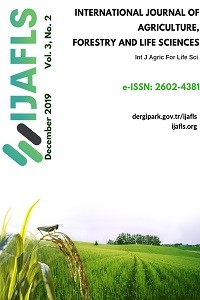Abstract
Project Number
No project
References
- Ref 1 Prof Dr Mohamad Omar KabeshField Crop Research Dep NRCEgypt
- Ref 2 Prof Dr Saad Hassan Abou KhadrahKafr El Sheikh UnivFaculty of Agric ,Egypt
Abstract
In
order to determine the impact of different planting dates on mungbean varieties
as double purpose crop for vegetable and seed yields, field trials were
conducted in clay soil in Qalubia governorate, during 2017 and 2018 summer seasons.
Kawmy-1 and V2010 varieties were sown at 5 dates every two weeks namely, 15/5
(D1), 1/6 (D2), 15/6 (D3), 1/7 (D4) and 15/7 (D5). The results showed that Kawmy-1 surpassed V2010
in plant height, no. of pods palnt-1, seed yield plant-1 as
well as seed yield ha-1 in the 1st and 2nd
harvests at 80 and 100 days after sowing respectively and total seed yield ha-1.
Regardless planting date Kawmy-1 was earlier in 50% flowering period and
produced > 50% of sed yield plant-1 and seed yield ha-1
of the total seed yield at the 1st harvest (80 days after sowing)
compared with V2010. There were not significant effects among different
planting dates in flowering until 1/7 planting date (D4) thereafter, the
flowering duration was significantly shortened. Plant height was not affected
till 1/6 planting date (D2) thereafter, it was gradually declined. The best
seed yield ha-1 was attained at 15/5 and 1/6 planting dates (D1 and
D2), and in the subsequent planting dates it reduced gradually in the later
planting dates. The planting date 15/5 (D1) gave the highest seed yield ha-1
and surpassed D2 without significant differences among D2 and D3, D4 and D5 in
the total seed yield ha-1. The interaction between variety and
planting date showed that Kawmy-1 was superior in seed yield ha-1
when it was sown either in D1 (15/5) or D2 (1/6) followed by V2010 when it was
planted at D1. The results of mungbean as vegetable crop indicated that Kawmy-1
variety produced greater green pods yield than V2010. Gradual reductions in
green pods yield as planting date retarded and the best green yield pods was
reported at D1 planting date. Regarding the interaction effect between variety
and planting date on green yield pods, the results showed that the best
planting dates were D1 and D2 for both varieties to produce the greatest green
pods yield. It could be concluded that mungbean could be used as double purpose
crop ether for green pods or dry seed which permits this crop to expand its
uses under Egyptian conditions. The results emphasized that mungbean is among
the most temperature sensitive crops and its production could fluctuate with a
slight change in temperature due to planting dates which could be observed from
the lower yields in the later planting dates compared with the best planting
date D1.
Supporting Institution
National Research Centre
Project Number
No project
References
- Ref 1 Prof Dr Mohamad Omar KabeshField Crop Research Dep NRCEgypt
- Ref 2 Prof Dr Saad Hassan Abou KhadrahKafr El Sheikh UnivFaculty of Agric ,Egypt
Details
| Primary Language | English |
|---|---|
| Subjects | Agricultural, Veterinary and Food Sciences |
| Journal Section | Original Papers |
| Authors | |
| Project Number | No project |
| Publication Date | December 23, 2019 |
| Submission Date | September 3, 2019 |
| Acceptance Date | November 26, 2019 |
| Published in Issue | Year 2019 Volume: 3 Issue: 2 |
Cite
lThe "International Journal of Agriculture, Forestry and Life Sciences" (IJAFLS) content is licensed under a Creative Commons Attribution-NonCommercial (CC BY-NC) 4.0  International License which permits third parties to share and adapt the content for non-commercial purposes by giving the appropriate credit to the original work. Authors retain the copyright of their published work in the International Journal of Agriculture, Environment and Food Sciences.
International License which permits third parties to share and adapt the content for non-commercial purposes by giving the appropriate credit to the original work. Authors retain the copyright of their published work in the International Journal of Agriculture, Environment and Food Sciences.

